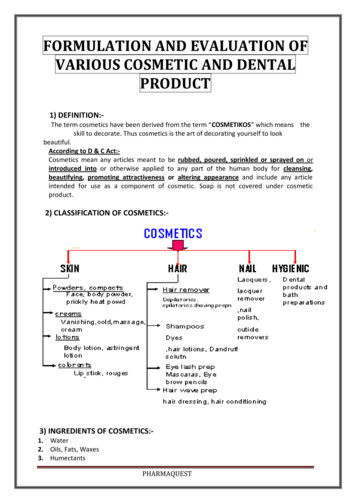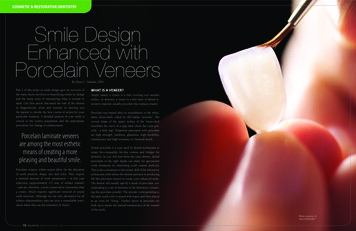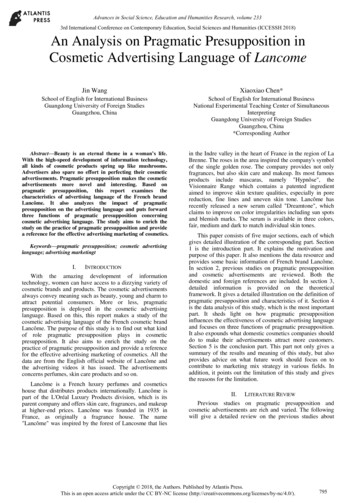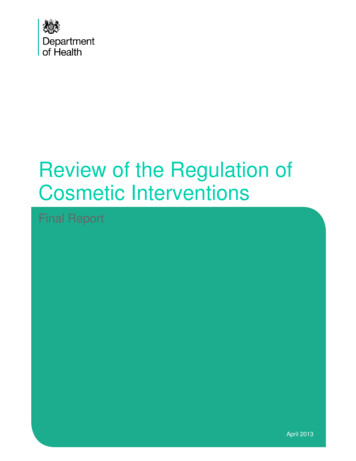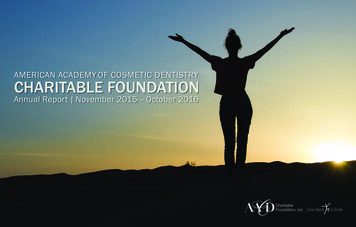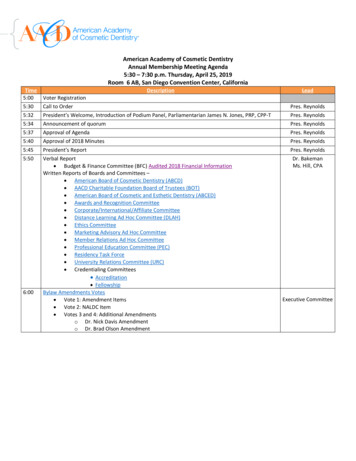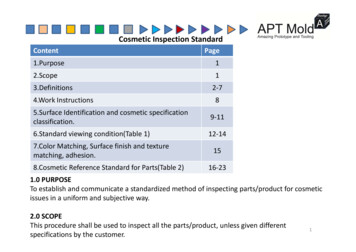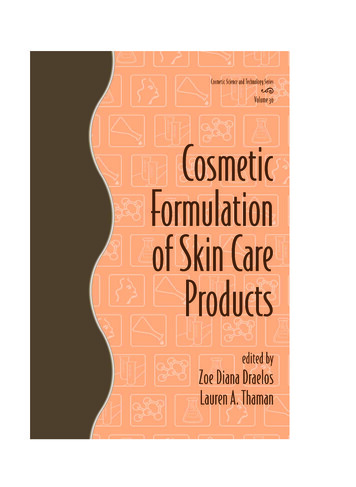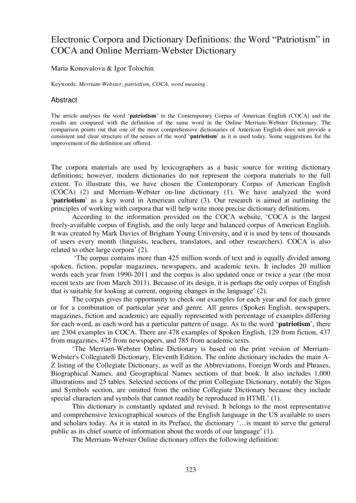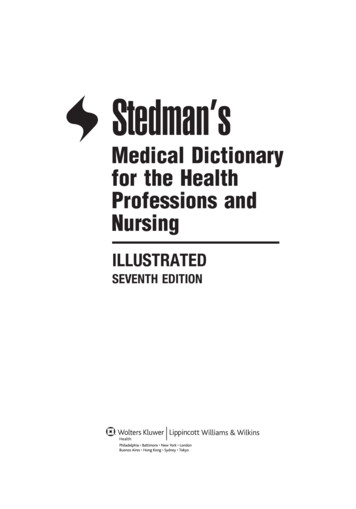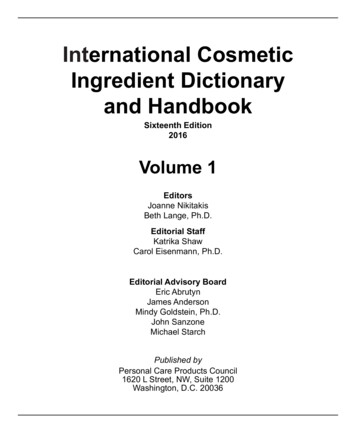
Transcription
International CosmeticIngredient Dictionaryand HandbookSixteenth Edition2016Volume 1EditorsJoanne NikitakisBeth Lange, Ph.D.Editorial StaffKatrika ShawCarol Eisenmann, Ph.D.Editorial Advisory BoardEric AbrutynJames AndersonMindy Goldstein, Ph.D.John SanzoneMichael StarchPublished byPersonal Care Products Council1620 L Street, NW, Suite 1200Washington, D.C. 20036
No portion of the International Cosmetic Ingredient Dictionary and Handbook may be reproduced in whole or in part inany form or by any electronic or mechanical means, including information storage and retrieval systems, without priorwritten permission from the Personal Care Products Council, 1620 L Street, N.W, Suite 1200, Washington, DC 200364702.The International Cosmetic Ingredient Dictionary and Handbook contains information about ingredient labeling requirements in the United States, the European Union, and other countries. This information is based on publicly availableinformation. While every effort was made to ensure its accuracy and timeliness, compliance with the laws and regulations of the United States, the European Union, or other countries is solely the responsibility of the user of the Dictionaryand Handbook. The Personal Care Products Council cannot be held responsible for any specific or general use of theinformation in the Dictionary and Handbook and disclaims any liability arising from reliance thereon.The INCI Names presented in the International Cosmetic Ingredient Dictionary and Handbook are the result of substantialefforts by the Personal Care Products Council Staff and a committee of experts from the industry, academia and government. INCI Names are developed and assigned on the basis of established nomenclature conventions published by thePersonal Care Products Council.The material as presented in this format is unique and found nowhere else. The compilation and arrangement of theinformation for convenient reference represents an extensive amount of staff resources, judgment, effort, and time, andcontributes to the originality of the text. The International Cosmetic Ingredient Dictionary and Handbook is fully copyrighted and may not be copied by any means without the written permission of the Personal Care Products Council.Concerning U.S. Patent and Trademark Rights: The inclusion in the International Cosmetic Ingredient Dictionary andHandbook of a monograph of any cosmetic ingredient, in respect to which patent or trademark rights may exist, shall notbe deemed, and is not intended as, a grant of, or authority to exercise, any right or privilege protected by such patent ortrademark. All such rights and privileges are vested in the patent or trademark owner, and no other person may exercisethe same without express permission, authority, or license secured from such patent or trademark owner.Copyright 1973, 1977, 1982, 1985, 1991, 1993, 1995, 1997, 1999, 2001, 2003, 2005, 2007, 2009, 2011, 2013, 2015Personal Care Products CouncilAll rights reserved.Library of Congress Catalog Card No. 2015956201ISBN 1-882621-55-7 (5-volume set)PRINTED IN THE UNITED STATES OF AMERICA
ContentsVolume 1 of 5Foreword. vPreface. viiDedication. ixAcknowledgments. xiIntroductionA. Regulatory and Ingredient Use Information. xvB. Specific Disclaimers. xxiiiC. Labeling Reminders. xxiiiD. INCI Name Assignment Procedures.xxivE. Ingredient Sources. xxvF. Nomenclature Conventions.xxviG. Abbreviations.xlviH. Information Sources. xlviiiI. Retired INCI Names, and INCI Name Changes and Deletions. liSection I Monographs (A through H). 1
iv IntroductionInternational Cosmetic Ingredient Dictionary and Handbook
ForewordThe Personal Care Products Council is pleased to present the new Sixteenth Edition of theInternational Cosmetic Ingredient Dictionary and Handbook (Dictionary). This edition represents over 40 years of continuing effort in the development of a unique nomenclature system for the world’s cosmetic ingredients.Through the years, the Dictionary has undergone many revisions dictated by changes in the marketplace, in the availability of new and exciting raw materials developed through innovative technologies, and in regulatory requirementsin countries that recognize INCI (International Nomenclature Cosmetic Ingredient) labeling names. It is the goal of thecosmetic industry to have a single worldwide reference, based on sound science, which will allow the consistent identification of the composition of personal care products.The widespread use and international recognition of INCI names can be attributed to the use of uniform, science-basedingredient names that minimize the language barriers that can hinder consumer understanding and international trade.The concept of uniform labeling names has received widespread support from ingredient and finished product manufacturers, the scientific and medical community, and regulatory bodies in the United States and elsewhere. A key elementof this acceptance is the establishment of a single ingredient labeling name for each material that promotes a commonunderstanding throughout the world.The Personal Care Products Council is committed to working with national governments, trade associations, and otherorganizations to ensure that the Dictionary provides the world community with accurate, transparent, and harmonizednomenclature.Cosmetics Europe representing the national cosmetic trade associations of the European Union Member States, theJapan Cosmetic Industry Association, and other organizations around the world work with the Council to ensure that INCInomenclature accommodates differing approaches in national laws and regulations.This edition of the Dictionary, as with previous editions, is published by the Personal Care Products Council as a service to the industry, to the scientific community, and to the world’s consumers. We hope it proves to be an especiallyvaluable reference.Lezlee J. Westine, President & CEO, Personal Care Products CouncilBeth Lange, Ph.D., Chief Scientist and Executive Vice President – Science, Personal Care Products CouncilInternational Cosmetic Ingredient Dictionary and HandbookIntroduction v
vi IntroductionInternational Cosmetic Ingredient Dictionary and Handbook
PrefaceThe International Cosmetic Ingredient Nomenclature Committee was established by the Council more than forty-fiveyears ago to assign unique, standardized names to cosmetic ingredients (INCI names). While initiated as a U.S. program, within a decade it became an international effort as cosmetic product labeling emerged in other jurisdictions aroundthe world. Today, more than 22,000 globally-recognized INCI names have been developed from submissions by morethan 3000 ingredient suppliers in approximately100 countries.Developing a uniform approach to name a diverse group of thousands of raw materials is no small task. Over time, a setof rules has been developed which have as their foundation that INCI names be based on chemical composition. Theseguiding principles are well-described in the Introduction as Nomenclature Conventions. Readers are encouraged to consult this section for a full discussion on the rules for the assignment of INCI names.Substance identification has become increasingly complex as a result of the scientific and technological changes associated with raw material production. In many cases, the naming principles originally set forth are not entirely applicable tohandle the complexity and diversity of today’s ingredients. Some examples include the challenges presented with namingmaterials derived through recombinant processes, biotech processes, and tissue culture preparations, not to mention thenaming of increasingly complex polymers and protein-polymer conjugates. While the Nomenclature Committee makesevery effort to not change established INCI names, revisions to names and changes in approach are sometimes unavoidable.Included in this edition is the retirement of several INCI names that relate to terms which have a long history of use.While “retired” may imply that the name is no longer in use, such names are considered to be “grandfathered” and havebeen replaced by more accurate terminology. Both the retired INCI name and its replacement will be published for an interim transition period in order to facilitate ingredient identification, and minimize business disruption until the retired nameis eventually removed from publication. In practice, the retirement of an INCI name is considered with discretion.A new feature introduced in this edition is the identification of the currently accepted scientific name for a large number ofplants. Experts in the field of botany were consulted for this task which undoubtedly will be an ongoing project as moreplant materials find usage in cosmetics. There are notable differences between INCI names for botanicals and the relatedaccepted scientific names; and to clarify these differences the monograph definitions have been expanded to describe thecurrent scientific nomenclature. Additionally, an index has been included to cross-reference the accepted scientific namewith the INCI terms. The accepted scientific names will continually be reviewed and updated consistent with the findingsfrom taxonomic research. At some point in the future, the INCI names may be amended to reflect the current speciesinformation.The Nomenclature Committee, together with the Council, hope that this edition of the Dictionary will be especially informative to the global community, and stand ready to address any questions or recommendations for future improvement.Joanne NikitakisDirector, Cosmetic ChemistryInternational Cosmetic Ingredient Dictionary and HandbookIntroduction vii
viii IntroductionInternational Cosmetic Ingredient Dictionary and Handbook
DedicationThe Sixteenth Edition of the International Cosmetic Ingredient Dictionary and Handbook reflects the dedication of manytalented scientists during the past forty-three years. In recognition of their commitment and expertise, this edition is dedicated to six notable individuals:John Sanzone, Chairman of the International Cosmetic Ingredient Nomenclature Committee, has been a member of theCommittee since 1996, providing leadership as its Chair for the past five years. The majority of John’s career has beenat the Estee Lauder Company where he serves as Executive Director of Regulatory Affairs. Throughout his tenure, Johnhas provided keen insight on the global impact and harmonization of INCI nomenclature. As Chair, he continues to guidestandardized name development through a challenging period of ingredient diversity, consumer awareness, and changein the global landscape.Eric Abrutyn has been a member of the Committee since 1994, and served as the committee’s Chair from 2002-2010.Eric retired from the industry as senior scientist at Kao Brands where he provided expertise in skin and hair care productdevelopment. Eric also worked in the raw material sector at Wickhen Products and Dow Corning. He has authored overa dozen patents, and is currently an industry consultant. Eric continues to provide guidance to INCI nomenclature development.Jim Anderson has been a member of the Committee since 1997, and serves as Chair of the Subcommittee for GeneralChemistry. Jim is an organic chemist with specific expertise in the synthesis of hair dyes. He recently retired from his position as a senior scientist in the Beauty Care Division of Procter & Gamble. The bulk of Jim’s career was spent at Clairolwhere he served as a senior research investigator and authored over a dozen patents.Mindy Goldstein, Ph.D., has been a member of the Committee since 1994, and serves as Chair of the Subcommittee forBiotechnology. Mindy is a biochemist with keen expertise in biological skin care and hair care ingredients. For the past25 years, she has worked in a number of industry research positions, and most recently as Vice President of Research& Development at Atlantic Coast Brands. Mindy has also been a very active leader in the Society of Cosmetic Chemistswhere she served as President, and chaired the Committee on Scientific Affairs for a number of years.Mike Starch, has been a member of the Committee since 1997, and serves as Chair of the Subcommittee for Polymers.Mike is a polymer chemist with specific expertise in silicone chemistry. He recently retired after serving 13 years as aresearch scientist at the Dow Corning Corporation, and 15 years as a group leader in product development at the AndrewJergens Company (Kao Brands).Kathleen Corey is the computer scientist, who, for the past thirty-five years, has been solely responsible for creating thesoftware that manages the ingredient data bases, and programming for the Dictionary production. Her commitment, extensive knowledge, expert analytical skills, and keen eye for detail have been an immeasurable asset to this work.On behalf of the industry and global community of Dictionary users, the Council expresses its appreciation for the talentand commitment of these scientists. A work of this magnitude could not be completed without their invaluable knowledge,dynamic leadership, and the synergy created through their exceptional teamwork. It has been both a privilege and a pleasure to work with each of them over the course of many years.Joanne NikitakisInternational Cosmetic Ingredient Dictionary and HandbookIntroduction ix
x IntroductionInternational Cosmetic Ingredient Dictionary and Handbook
AcknowledgmentsThe Council wishes to acknowledge and thank the following individuals and their organizations for their dedication to the developmentof the International Cosmetic Ingredient Dictionary and Handbook, 16th edition:International Nomenclature CommitteeJohn Sanzone, Chairman, Estée Lauder CompaniesEric Abrutyn, ConsultantPatricia Aikens, Ph.D., BASFJames Anderson, ConsultantKarolina Brzuska, Cosmetics EuropeGaetano Castaldo, Ph.D., European CommissionFederica DeGaetano, Ph.D., European CommissionMichael J. Fevola, Ph.D., Johnson & Johnson Consumer and Personal ProductsJohn Gardlik, Ph.D., The Procter & Gamble CompanyMindy Goldstein, Ph.D., Atlantic Coast Media GroupBart Heldreth, Ph.D., Cosmetic Ingredient ReviewLaurie Joseph, Ph.D., Rutgers, The State University of New JerseyPeter Kaufmann, ConsultantAkihiro Kinoshita, Ph.D., Shiseido America, Inc.Robert Y. Lochhead, Ph.D., University of Southern MississippiKhalid Mahmood, Ph.D., Johnson & Johnson Consumer and Personal ProductsStanley Milstein, Ph.D., U.S. Food and Drug AdministrationJoanne Nikitakis, Personal Care Products CouncilClaude Salilou, PharmD., Ph.D., Estee Lauder CompaniesKatrika Shaw, Personal Care Products CouncilMike Starch, ConsultantDavid Story, Kao Brands CompanyColleen Sutton, Ph.D., Health CanadaRyuji Sugai, Kanebo Cosmetics, Inc., JCIA LiaisonKrishnan Tamaraselvey, LubrizolMiao Wang, L’Oreal USA, Inc.Willem van der Wilden, Ph.D., Life SciencesShontell Wright, U.S. Food and Drug AdministrationChao Zhu, L’Oréal USA, Inc.Special Experts:Lawrence Callahan, Ph.D., Substance Registration System, U.S. Food and Drug AdministrationKate Langen Corey, Data Doctor, Inc.Carol Gardner, Ph.D, Rutgers, The State University of New JerseyLena Struwe, Ph.D., Rutgers, The State University of New JerseyFrank Switzer, Ph.D., Substance Registration System, U.S. Food and Drug AdministrationPersonal Care Products Council Staff:Natasha Clover, Manager, Publications and MarketingCarmela Wingfield, Science CoordinatorStephanie Johnson, Science SpecialistInternational Cosmetic Ingredient Dictionary and HandbookIntroduction xi
xii IntroductionInternational Cosmetic Ingredient Dictionary and Handbook
IntroductionHistorical PerspectiveIn the 1940s, the cosmetic industry recognized a lack of information on the composition of common cosmetic ingredients. To address this problem, a Board of Standards was instituted by the Toilet Goods Association (re-named as theCosmetic, Toiletry, and Fragrance Association, CTFA, in 1971, and the Personal Care Products Council in November2008.) The TGA Board worked to develop standards for common ingredients, and sponsored annual scientific meetingsto address specific issues of importance to cosmetic chemists.Two decades later, there was heightened interest in the public sector about the safety of cosmetic products. As theimportance of cosmetic ingredient labeling emerged, the industry realized that little public information was available oningredients used in its products. The Council responded quickly to this need by surveying cosmetic companies for listsof its cosmetic raw materials. This effort revealed that ingredients were identified by multiple, synonymous terms. TheCouncil’s effort to clarify the names from this survey marked the beginning of the development of a uniform nomenclaturesystem for cosmetic ingredient identification.In 1972, the Association presented a formal recommendation to FDA outlining two possible approaches for cosmeticingredient labeling: one based on generic names for ingredients, and one based on specific names. FDA responded thatthe names must be specific and based on chemical structure or composition. Shortly thereafter, the Council establisheda committee charged with creating uniform names for cosmetic ingredients using guidelines recommended by the FDA.The Committee consisted of industry experts in the fields of chemistry and cosmetic science and technology, as well asrepresentatives from the American Medical Association, the U.S. Adopted Names Council, and the U.S. Food and DrugAdministration. The compilation of uniform names (CTFA Adopted Names) and related technical information led to thepublication of the First Edition of the CTFA Cosmetic Ingredient Dictionary in 1973. Soon thereafter, the FDA published aproposed regulation, under the authority of the U.S. Fair Packaging and Labeling Act, requiring cosmetic ingredient labeling in the United States (U.S. Title 21, Code of Federal Regulations, Part 701.3). When the final regulation was published,the First Edition of the Dictionary was cited as the primary source of ingredient names for labeling cosmetic products.In acknowledgment of the broadening use of this cosmetic nomenclature around the world, the “CTFA Adopted Name”designation was changed to “International Nomenclature Cosmetic Ingredient” or INCI Name in 1993, and the title, CTFACosmetic Ingredient Dictionary, was revised to International Cosmetic Ingredient Dictionary. The title was changedagain for the Seventh Edition (1997) to the International Cosmetic Ingredient Dictionary and Handbook to recognize theaddition of Chemical Classes, Functions, and Reported Product Categories formerly contained in the separate publication, the International Cosmetic Ingredient Handbook. While the Dictionary provides a comprehensive international reference of descriptive and technical information about materials which have been identified as potential cosmetic ingredients, to gain insight on the actual usage of ingredients in the United States, in 2011 the Council developed and publishedthe Compilation of Ingredients Used in Cosmetics in the United States. The Compilation is based on ingredients reportedto the U.S. Food and Drug Administration (FDA) through the Voluntary Cosmetics Registration Program (VCRP) andidentifies over 6,000 ingredients registered with FDA. Each year the data base for the Dictionary is updated with VCRPinformation, and this information is available through the Council’s online InfoBase.There are many benefits to a uniform global system of labeling names for cosmetic ingredients, including the transparency provided to consumers regardless of the national origin of the product. In addition, dermatologists and others in themedical community are ensured an orderly dissemination of scientific information, which helps to identify agents responsible for adverse reactions.Furthermore, scientists are ensured that information from scientific and other technical publications will be referencedby a uniform name and that multiple names for the same material will not lead to confusion, misidentification, or the lossof essential information. Finally, the cosmetic industry is able to track the safety and the regulatory status of ingredientsefficiently on a global basis, enhancing its ability to market safe products in compliance with various national regulations.International Cosmetic Ingredient Dictionary and HandbookIntroduction xiii
In 1993, the European Commission (EC or the “Commission”) recognized the need to promote cosmetic ingredient labeling in the European Union (EU), and cited the International Cosmetic Ingredient Dictionary as a source for ingredientnomenclature. The Council’s International Nomenclature Committee worked with a team established by the EU cosmeticindustry trade association (Colipa, now called Cosmetics Europe) to ensure that INCI labeling names would be acceptable in both the U.S. and the EU. In 1996, Colipa prepared an inventory of cosmetic ingredients based on the sixthedition of the Dictionary. The Commission first published this inventory on June 1, 1996 (Commission Decision 96/335/EEC) to serve as a reference document for cosmetic ingredient labeling nomenclature for the EU Member States. Theinventory and subsequent updates have been replaced by the current regulation, No. 1223/2009.In March 2000, the Japanese government issued a three year deregulation strategy, and amended the PharmaceuticalAffairs Law (Ordinance to Partially Amend Enforcement Regulations of the Pharmaceutical Law), MHLW Notice No. 125of 2000, Cosmetic Ingredients; MHLW Notice No. 330, of September 2000, the Cosmetic Standard; MHLW Notice No.331 of September 29, 2000; and MHLW Notice No. 332 of September 2000, Determination of Quasi-drug and CosmeticIngredients that are Designated by the Ministry of Health as Ingredients that Require Labeling. These regulations, whichwere effective April 1, 2001, require full ingredient labeling using INCI names translated or transliterated into the Japaneselanguage. In November 2013, the Japanese government promulgated the Law for Partial Revision of the PharmaceuticalAffairs Law (Act No.84 of 2013), which went into effect on November 25, 2014 with the revised title - The Law on SecuringQuality, Efficacy and Safety of Products including Pharmaceuticals and Medical Devices (abbreviated as the PMD Act).In addition to the United States, the EU and Japan, other countries have recognized the need for uniformity in cosmeticingredient nomenclature and have formally identified the Dictionary in their regulations. A current listing by country isprovided below: Argentina: ANMAT Disposición 374/2006: Productos de hygiene personal, cosmeticos y perfumes Australia: Trade Practices (Consumer Product Information Standards, Cosmetics) Regulations, Statutory Rules 1991 Canada: Regulations Amending the Cosmetic Regulations of the Canadian Food and Drug Act, 2004. China: Ministry of Public Health Stipulation of the Application and Assessment for Cosmetic Products, Article 9,Paragraph 3, effective May 1, 1999. Colombia: Decision 516, Andean Community Commission, March 8, 2002 Israel: The Pharmacists’ Regulations (Cosmetics) 2011-5772 Korea: KFDA Notification No. 2010-99 as of December 31, 2010 Mexico: NOM-141-SSA1/SCFI-2012 Mexican Official Standard, Labeling prepackaged cosmetics, September 19,2012. Norway: European cosmetics regulations (EC) No 1223/2009, effective July 11, 2013 Saudi Arabia: Saudi Arabian Standards Organization (SASO) 1953, 8.17.6 South Africa: South African Standards Act No. 29 of 1993. ASEAN region (Brunei Darussalam, Cambodia, Indonesia, Malaysia, Myanmar, Lao PDR, Philippines, Singapore,Thailand, Vietnam), Agreement on the ASEAN Harmonized Cosmetic Regulatory Scheme (AHCRS), January 1, 2008.The Dictionary is also recognized as a source of ingredient names in Brazil, Costa Rica, Argentina, the Customs Union(Belarus, Kazakhstan, and the Russian Federation).xiv IntroductionInternational Cosmetic Ingredient Dictionary and Handbook
A. Regulatory and Ingredient Use InformationNotice to UsersThis edition of the International Cosmetic Ingredient Dictionary and Handbook (Dictionary) continues the use of ingredient names established to minimize the differences in the nomenclature recognized by regulatory authorities in the UnitedStates and the European Union (EU) and Japan. Users should review the information that follows, and consult applicablenational laws and regulations to ensure the INCI (International Nomenclature Cosmetic Ingredient) names used for labeling are appropriate for their intended markets. The types of ingredients, most frequently affected are:ColorantsBotanicals (Plant-Derived Ingredients)Denatured AlcoholsU.S. Over-the-Counter (OTC) Drug IngredientsTrivial NamesFragrances/ParfumFlavors/AromasUsers of the Dictionary must note that labeling names for ingredients in the above categories intended for sale in the United States may be different from those intended for sale in the European Union, Japan, or in other countries.The regulatory and ingredient use descriptions contained in this edition of the Dictionary are based on informationavailable to the Council as of September 1, 2015. Changes to regulatory and use information after this date are availablefrom the Council.1. U.S. Color AdditivesThe term “color additive” is defined, in part, by U.S. law as a material which:(A) is a dye, pigment, or other substance made by a process of synthesis, or similar artifice, or extracted, isolated, or otherwise derived, with or without intermediate or final change of identity, from a vegetable, animal, mineral, or other source,and;(B) when added or applied to a food, drug, or cosmetic, or to the human body or any part thereof, is capable (alone orthrough reaction with other substances) of imparting color thereto. Federal Food, Drug, and Cosmetic Act, (FD&C Act)Section 201(t)(1).In the United States, a cosmetic containing a colorant (except a coal-tar hair dye) that is not approved by the FDA is regarded as “adulterated” and subject to regulatory action by FDA. Federal Food, Drug, and Cosmetic Act, Section 601(e).NOTE -An exception to this requirement exists for “coal-tar” (synthetic organic) colorants used in hair dyes, providedother regulatory requirements are met (see information in this section under U.S. Hair Colorants and the U.S. HairDye Exemption).U.S. Color Additives approved for use in the United States are listed in Title 21 of the U.S. Code of Federal Regulations,21 CFR, Parts 74, and 82.International Cosmetic Ingredient Dictionary and HandbookIntroduction xv
A listing of the INCI names of U.S.-approved colorants may be found in the Dictionary, under Chemical Classes, listedunder the following headings: ColorAdditives -Batch Certified by the U.S. Food and Drug Administration ColorAdditive Lakes -Batch Certified by the U.S. Food and Drug Administration ColorAdditives -Exempt from Batch Certification by the U.S. Food and Drug AdministrationColor Additives Subject to Batch CertificationWith the exception of “coal-tar” hair dyes, all “synthetic organic” color additives are subject to batch certification by theFDA. Each batch of an approved synthetic organic colorant must be tested and certified by the FDA as meeting standardsand specifications found in 21 CFR 74.Color Additives Exempt from Batch CertificationSome U.S.-approved colorants are exempt from batch certification by the FDA. In order to be legally used in the U.S.,however, these colorants must meet specification and use restrictions stipulated in 21 CFR 74.Abbreviated Labeling Names for U.S. ColorantsOfficial names for colorants subject to batch certification may be found in the listing of the color additive in 21 CFRParts 74, and 82. These names must be used by the colorant manufacturer to identify the color additive product (orraw material) that has been batch certified by the FDA. As discussed below, FDA currently does not object to abbreviated labeling for declaring the presence of certified batches of color additives in cosmetics. 032.htmFDA originally proposed the use of abbreviated names for U.S. colorants in the Federal Register on June 6, 1985 (50 FR23815). At that time, the FDA stated that firms may use the abbreviated names on product labels. By correspondence, datedJune 7, 1999, the FDA reaffirmed its intention to permit cosmetic firms to use the abbreviated names on product labels while afinal rule on the matter is pending. The abbreviated labeling names apply only to U.S. color additives that are subject to batchcertification. Under this scheme, the cosmetic product manufacturer does not have to include “FD&C” or “D&C,” “No.,” or thetype of lake “Aluminum, Zirconium, e
No portion of the International Cosmetic Ingredient Dictionary and Handbook may be reproduced in whole or in part in any form or by any electronic or mechanical means, including information storage and retrieval systems, without prior written permission from the Personal Care Products Counc

